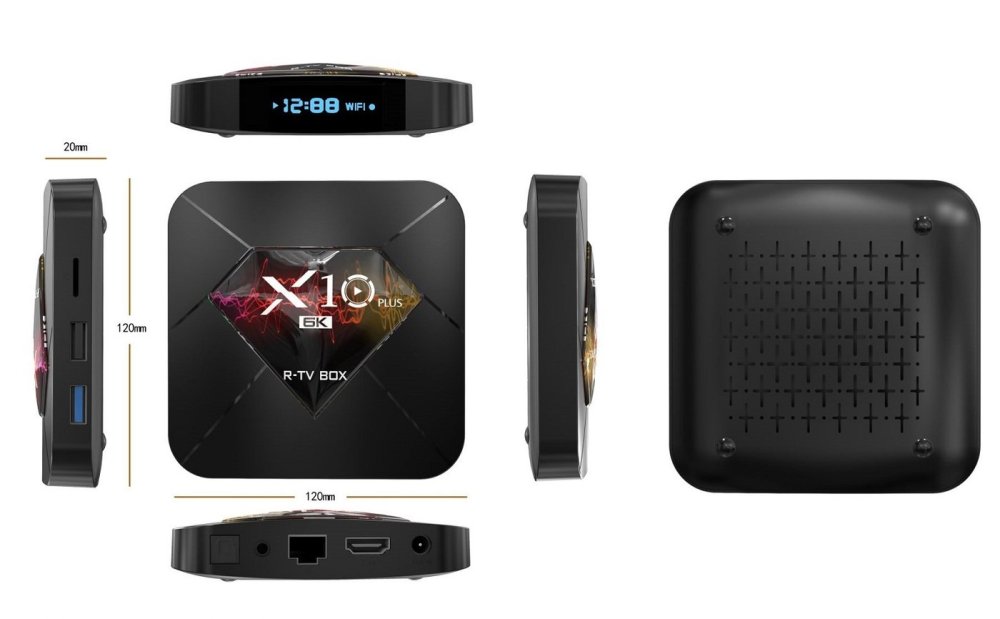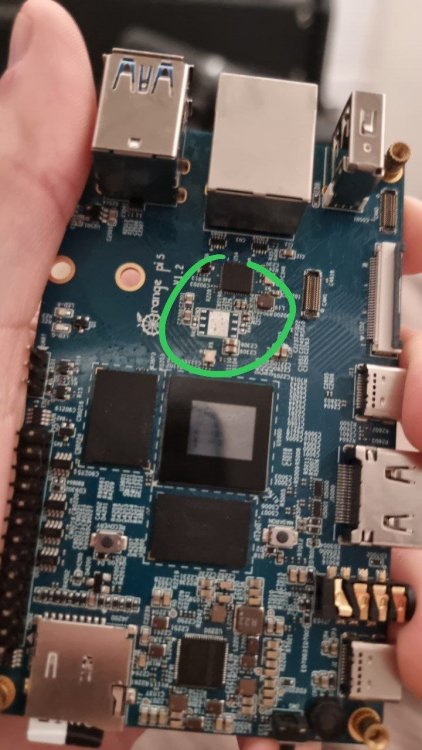All Activity
- Today
-

TVBOX M4xq with ik316 EMCP 1.0
Aleqssandro Farias replied to javaxsousa's topic in Allwinner CPU Boxes
Hi @Nick A, This ISO you sent has the same UART log error as the previous one. Here's the log: " U-Boot SPL 2025.01-armbian-2025.01-S6d41-P7151-H8869-V98f7-Bb703-R448a-dirty (Apr 02 2025 - 21:19:05 -0400) DRAM: testing 32-bit width, rank = 2 read calibration failed! testing 32-bit width, rank = 1 read calibration failed! testing 16-bit width, rank = 2 read calibration failed! testing 16-bit width, rank = 1 read calibration failed! This DRAM setup is currently not supported. resetting ... " Right now, the only image that boots properly is the MiniArch one. -
Well, folks say it is being worked on - https://git.kernel.org/pub/scm/linux/kernel/git/torvalds/linux.git/commit/?id=71025ec7f7767 Decoding works so I was hoping it did progress but may be not.
-
If Allwinner does not provide C-source code (kernel, libs, ffmpeg, etc) for recent Linux, I consider it as is; no encoding on Allwinner SoCs. I have several H3 boards, I also dreamed that I once maybe could use that for HEVC->H264 transcoding (low power 24/7 multiple TV channels) but it is not happening. I spent a lot of time to get it working on Pi4 and that breaks at various distro updates or just kernel updates. But RPL then hacks/fixes it in their custom ffmpeg, but it is only Pi4 and also limited, Pi5 has no HW encoding so even they as biggest SBC company give up on it I would say. Rockchip and Intel have fairly easy out-of-the-box solutions, but both not V4L2m2m.
-
Which image are you using? Axp313? https://github.com/NickAlilovic/build/releases/download/20250306/Armbian-unofficial_25.05.0-trunk_Tanix-tx6s-axp313_bookworm_edge_6.12.11.img.xz
-
@Aleqssandro Farias your miniarch image says it’s using Tanix TX6s (axp313). Try the armbian version. https://github.com/NickAlilovic/build/releases/download/20250306/Armbian-unofficial_25.05.0-trunk_Tanix-tx6s-axp313_bookworm_edge_6.12.11.img.xz
-
I have one on a shelf and want to use it for h265->h264 transcoding. http://www.orangepi.org/html/hardWare/computerAndMicrocontrollers/details/Orange-Pi-One-Plus.html says it can. H6 Quad-core 64-bit ARM Cortex™-A53 Decoding: H265/HEVC Main/Main10 profile@Level5.2 High-tier ;4K@60fps, up to 6Kx4K@30fps Encoding: H.264 BP/MP/HP encoder up to 4K@25fps or 1080p@60fps Googling finds some old branches of ffmpeg and kernel for H3. Current armbian 25.2.3 comes with 6.12.20-current-sunxi64 which has: sunxi_cedrus v4l2_mem2mem videobuf2_dma_contig videobuf2_v4l2 videodev videobuf2_common mc so the kernel seems to be aware of my specific chip (hence sunxi_cedrus) and modern Kodi seems to support decoding but nothing about encoding. Is that it, encoding is just not supported and my Pi is only good as a player? ps. sadly there is no One Plus specific forum and no common Sunxi forum and for some reason I must choose one of the boards and hence Quadra which seems using H6.
-
-
AFAIR someone on this forum also experienced booting issue with orange pi board though 4 not 5 with quite similar symptoms. May be worth contacting that person for his results so far - might give some hints on what's going on and whether it's a manufacturing fault
-

Cannot boot a built linux image from SD card.
Werner replied to Krishna0's topic in Radxa Rock 5 ITX
Hm if an image works but self-made won't either means something has been messed up which I doubt since it fails at uboot level. Or a change in the code broke it in the mean time. Also interesting that kernel building fails when RKNPU is a module rather than built-in. I guess that goes to poor implementation on Rockchip's side. Which exact pre-built image did you test that works well? This is quite old. We had a few version bumps in the mean time. More recent vendor kernels should already contain 0.9.8 What you could also try is to integrated the most recent patch series for mainline npu driver into edge kernel: https://patchwork.kernel.org/project/linux-rockchip/cover/20250519-6-10-rocket-v4-0-d6dff6b4c0ae@tomeuvizoso.net/ -
Yes, DB9 won't work. But if, as eselarm mentions, a proper chip is on board already a simple usb-a to usb-c or c-to-c cable should do. Check dmesg when connection to see what pops up.
-
These things can happen, yes. Sometimes old vendor-style uboot cannot process a modern mainline kernel and vice versa. Glad to hear it worked well this time.
- Yesterday
-
Hi, I am currently using rock-5-itx to setup a NAS. Everything is working fine. uname -a: Linux amberbyte 6.1.75-vendor-rk35xx #1 SMP Thu Nov 28 03:16:11 UTC 2024 aarch64 GNU/Linux Now, I wanted to update RKNPU version from 0.9.7 to 0.9.8. So, again I recompiled the image with the updated drivers. Using Pi-imager flashed it onto an SD card. When I tried to boot I am getting the following error message from the serial output: ./compile.sh build BOARD=rock-5-itx BRANCH=vendor BUILD_DESKTOP=no BUILD_MINIMAL=yes EXPERT=yes KERNEL_CONFIGURE=yes RELEASE=bookworm DDR 9fffbe1e78 cym 24/02/04-10:09:20,fwver: v1.16 LPDDR5, 2400MHz channel[0] BW=16 Col=10 Bk=16 CS0 Row=16 CS1 Row=16 CS=2 Die BW=16 Size=4096MB channel[1] BW=16 Col=10 Bk=16 CS0 Row=16 CS1 Row=16 CS=2 Die BW=16 Size=4096MB channel[2] BW=16 Col=10 Bk=16 CS0 Row=16 CS1 Row=16 CS=2 Die BW=16 Size=4096MB channel[3] BW=16 Col=10 Bk=16 CS0 Row=16 CS1 Row=16 CS=2 Die BW=16 Size=4096MB Manufacturer ID:CH0 RX Vref:26.3%, TX Vref:21.0%,21.0% CH1 RX Vref:27.1%, TX Vref:22.0%,22.0% CH2 RX Vref:27.1%, TX Vref:24.0%,21.0% CH3 RX Vref:27.5%, TX Vref:21.0%,20.0% change to F1: 534MHz change to F2: 1320MHz change to F3: 1968MHz change to F0: 2400MHz out U-Boot SPL board init U-Boot SPL 2017.09-armbian-2017.09-S2284-P8c48-Hfac6-Ve5ad-Bda0a-R448a (Nov 20 2024 - 17:06:35) Trying to boot from MMC2 spl: partition error Trying fit image at 0x4000 sector ## Verified-boot: 0 ## Checking atf-1 0x00040000 ... sha256(7612223b82...) + OK ## Checking uboot 0x00200000 ... sha256(af1962bdff...) + OK ## Checking fdt 0x00324010 ... sha256(e3b0c44298...) + OK fdt_record_loadable: FDT_ERR_BADMAGIC ## Checking atf-2 0xff100000 ... sha256(70505bb764...) + OK fdt_record_loadable: FDT_ERR_BADMAGIC ## Checking atf-3 0x000f0000 ... sha256(b2af21b504...) + OK fdt_record_loadable: FDT_ERR_BADMAGIC Jumping to U-Boot(0x00200000) via ARM Trusted Firmware(0x00040000) Total: 813.644/1063.106 ms INFO: Preloader serial: 2 NOTICE: BL31: v2.3():v2.3-868-g040d2de11:derrick.huang, fwver: v1.48 NOTICE: BL31: Built : 15:02:44, Dec 19 2024 INFO: spec: 0x1 INFO: code: 0x88 INFO: ext 32k is not valid INFO: ddr: stride-en 4CH INFO: GICv3 without legacy support detected. INFO: ARM GICv3 driver initialized in EL3 INFO: valid_cpu_msk=0xff bcore0_rst = 0x0, bcore1_rst = 0x0 INFO: l3 cache partition cfg-0 INFO: system boots from cpu-hwid-0 INFO: disable memory repair INFO: idle_st=0x21fff, pd_st=0x11fff9, repair_st=0xfff70001 INFO: dfs DDR fsp_params[0].freq_mhz= 2400MHz INFO: dfs DDR fsp_params[1].freq_mhz= 534MHz INFO: dfs DDR fsp_params[2].freq_mhz= 1320MHz INFO: dfs DDR fsp_params[3].freq_mhz= 1968MHz INFO: BL31: Initialising Exception Handling Framework INFO: BL31: Initializing runtime services WARNING: No OPTEE provided by BL2 boot loader, Booting device without OPTEE initialization. SMC`s destined for OPTEE will return SMC_UNK ERROR: Error initializing runtime service opteed_fast INFO: BL31: Preparing for EL3 exit to normal world INFO: Entry point address = 0x200000 INFO: SPSR = 0x3c9 No valid device tree binary found - please append one to U-Boot binary, use u-boot-dtb.bin or define CONFIG_OF_EMBED. For sandbox, use -d <file.dtb> initcall sequence 00000000002b8500 failed at call 00000000002aaf6c (err=-1) ### ERROR ### Please RESET the board ### I get the same error when I use the desktop image too: ./compile.sh build BOARD=rock-5-itx BRANCH=vendor BUILD_DESKTOP=yes BUILD_MINIMAL=no DESKTOP_APPGROUPS_SELECTED='browsers desktop_tools internet programming' DESKTOP_ENVIRONMENT=gnome DESKTOP_ENVIRONMENT_CONFIG_NAME=config_base EXPERT=yes KERNEL_CONFIGURE=yes RELEASE=bookworm But when I use the image downloaded from the armbian website is getting booted up without any issue and it has updated RKNPU drivers. But I have to build a kernel because I want the LSI MEGARAID drivers enabled. Also when I want to make RKNPU driver modular <M> it is unable to finish building the image with an error saying it is unable to find rknpu.ko. So, why is this happenning and is there a way to update the drivers without going through building the kernel? Thank you in advance and any help will be helpful.
-
Hey guys! Sorry it's been a while since the last update, here comes a good story with a sad ending hahah Ok, so! That's what I've done so far! Since i had to order some UART devices to check if I did get any output, it took a bit longer than expected, then i left the project on the sidelines, until... i got a hot air rework gun, so yeah I bought some SPI chips on the cheap and a programmer and did a test and succesfully wrote on them an read on them the binary file, so I proceded to completely desolder the SPI chip from the Orange Pi 5 and surprise!, The SPI was completely unreadable or unwritable, so we got that part right, SPI is dead. I thought that after removing the dead chip i might have some more luck with the UART device and tried to read info from it again... but no luck, nothing came out of it, so I thought I might be doing something wrong. The device is still stuck in maskrom mode. It goes straight to maskrom mode when you power it on, I also checked for shorts on the diodes or the press buttons, but they are all good. After a lot of chitchat with Gemini I tried to reflash the miniloaderall.bin from the website and suprise surprise, the miniloader, when booting the board pressing the maskrom mode manually, allowed to download the .bin file to the orange pi, BUT still no image, but If i do that I get something on the UART device. I get this funky message, according to the AI it seems that the CPU chip might be good but it can't read the RAM chips on the board, doesn't reach to that point and that would explain why it doesnt even try to boot from a microsd card anyway. So, my options are kinda bad now, it could either be a bad ball soldered on to the CPU chip that gets errors on reading the ram, or most likely a bad RAM chip on the board, problem is, at least according to the AI that soldering RAM chips with a soldering station without a pre heating board, its quite stresful for such delicate components, that I could easily break them by overheat and then I would not be able to repair the board anymore, obviously I tried all that as a learning process and I'm glad how far I've come, if anyone has any other idea or any suggestion, I could try that, I'm still thinking about going for the RAM desoldering process but I would need some replacements and if the risk of breaking those is that high might not be worth going as far as that. BTW the SPI chips i bought have the wrong package size and are like 2mm wider than the Orange Pi 5 layout and it doesn't fit, so I could not try to solder the new SPI chip back in, I would need to order some more with the correct package size, no big deal, SPI chip is cheap, ram chips are not as cheap.
-

CSC Armbian for RK322x TV box boards
Vinicius Guastala replied to jock's topic in Rockchip CPU Boxes
and I must say that not only your passion, but also your dedication and commitment are truly inspiring for the whole community! One just cannot thank you guys for everything you have done! @fabiobassa @jock @ilmich Since @jock provided the experimental image on May 12th, i've been playing non-stop with this device, doing numerous flashing attempts and testing things out, just for fun... I must have spent 30+ hours on this ever since, mostly trying to compile things myself to run in the box, playing with the different overlays to test what works and what doesn't and learning about Tee, trust, op-tee,... You know those kids that when get their toys, they tear it apart instead? well... same feeling... the discovery passion thing... I'm preparing a report on my findings for my specific "MXQ-EP-2-V1.0" MoBo model, specially around on the working overlays, perhaps I can post it in the weekend.... And responding to my own question earlier about armbian minimal, in the armbian-config tool from the experimental image, there is an option to disable desktop... it gives you a system with only 25 tasks running and lower RAM usage than a DietPi. Now I begin to become interested on (re)assembling ROM images... I've been trying to replace some internet roms with the Trust Partitions and u-boot from the ROM I know it works... No successful test yet, but not sure if I'm repacking them correctly... Anyway, I'm learning a lot and that's great thanks to this community! -
The NanoPi-R6C (that I have) has an extra USB-C female connector, so the chip is already on the board. You just need a USB cable (so just wires with USB signal levels) to connect to laptop or any computer with USB, even smartphone. RS232 is other voltage levels, long distance as well, so don't expect it to be spec compliant. USB is 5 meters. I think 1.5 Mbps is simply out of scope for RS232/DB9. Maybe netconsole is something you could use.
-
Installed the vendor kernel via armbian-config, booted up, it took a minute, thought it wouldnt boot, but it worked! now all the cpus are at 408Mhz when idle! Thank you so much!
-

CSC Armbian for RK3318/RK3328 TV box boards
Андрей Димов replied to jock's topic in Rockchip CPU Boxes
Incbot, hi I have this problem too. Use rk3318-config command to set device tree overlay (on the second step push space then enter) and then don't touch device tree overlay in armbian-config. After reboot use command hciconfig -a, if it have some message on screen - Bluetooth working -
Great thank you very much!
-

TVBOX M4xq with ik316 EMCP 1.0
Aleqssandro Farias replied to javaxsousa's topic in Allwinner CPU Boxes
Hi @Nick A, good afternoon! Yes, I tested them — I tried all three ISOs you shared. I'm sending you the UART logs from two of them: the one you specifically asked me to test and the MiniArch one. The one you asked me to try throws a DRAM error, while the MiniArch image actually boots — maybe because it’s configured for eMCP. log_miniarch.txt log_armbian_unofficial.txt -
Do you know of any products that integrate one of those chips such that you can plug in DB9 or RJ45 RS232 and achieve a console on a rockchip system that uses 1.5mbit @ TTL voltages? I have console cables that work now but via USB and I want to wire it up to my terminal server (ideally without having to do any soldering or work my own PCB).
-
Hi everyone, I'm recently obtained a TV box from a local store (seems like they sell Amazon returns or something, but they just have a bunch of random stuff). After installing AIDA64, I learned that it's running an Allwinner H616 CPU and has 4GB of RAM. It is able to boot warpme's MiniArch build for the Tanix TX6S, and I extracted the DTB from the Android build on the eMMC. My question is, where do I go from here? I'd like to build a custom Armbian image to support my device. When I try booting the Armbian image for the Orange Pi Zero 2, it gives an error over my serial monitor about a bad DRAM configuration which I expected since apparently these boxes have DRAM chips that are often laid out differently than the Orange Pi, and this can apparently be fixed with a U-boot configuration change. I was curious about how I can integrate these changes into my own build of Armbian so I could bring support to my device. Thanks in advance!
-

How to install armbian in h618?
Алексей Торопов replied to alienxz77b's topic in Allwinner CPU Boxes
Thank you, I tried. But this is not my level, it is too difficult for me. I'll probably wait for your next release.









